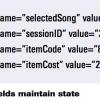The Latest
|
Should a Manager Know a Language?[magazine] Knowing C++ or Java can make a manager's job easier. But what about being an expert in spoken language? It's essential to be competent in the use of daily language when you are making the transition to management. Technical Editor Esther Derby gives advice on improving your language, including a warning about the dangers of using absolutes and of leaving out details in conversation. |
||
 |
Go Configure![magazine] Configuration management problems can derail the best of software projects. Walk through the basics of how to make CM work for—not against—you. |
Dwayne Phillips
July 30, 2002 |
|
Agile Meetings[magazine] Does the thought of going to yet another meeting make your head spin? Read about how to increase your team's productivity by making your meetings short, frequent, and focused. |
||
 |
Targeted Fault Insertion[magazine] Some programs must handle network errors, file system errors, and the like. Testing their error handling manually can be tedious and time consuming. Relying on accidental errors is unreliable and uncontrollable. Learn about a method for simulating errors that makes the process automated and flexible. |
Paul Houlihan
July 30, 2002 |
|
|
Forecasting Software Defects[magazine] The six weeks of testing you've been preparing for are suddenly reduced to one, but you still want to provide some assessment of overall quality. Read about this statistical approach to predicting the number of failed test cases in an application. |
|
|
Bug Tracking Basics[magazine] Effective bug tracking assures that bugs are logged, fixed, and verified by the appropriate personnel. Here's a beginner's guide to this process. |
Mitch Allen
July 30, 2002 |
|
|
What a Tangled Web[magazine] Web applications provide platforms so wide open that they defy the very structure and predictability that make test automation feasible. Object names are optional, can be duplicated, and may change at a moment's notice. Page layouts can change between and within builds. This wicked combination makes test automation even more difficult, if not downright impossible. Linda Hayes explains the importance of unique, consistent object names in Web development. |
||
|
Is There Light at the End of the Tunnel?[magazine] Losing your job is never easy, but the way you handle the experience has a direct impact on the results that you'll be able to achieve. Being laid off can make you question your abilities, but you have to roll with the punches, and enjoy your time off while you're looking for the next opportunity. |
Stefan P. Jaskiel
July 30, 2002 |
|
|
A Look at a Test Data Generator[magazine] When Pat McGee couldn't find the right tool for the job, he and his team wrote one in Visual Basic for Applications for Microsoft Excel. They used Excel for all the data entry and calculations. Several groups in the project ended up using the tool–including testers, developers, and database administrators. Read how they did it. |
Pat McGee
July 30, 2002 |
|
 |
Hidden Risks in Web Code[magazine] A look at the HTML source code behind Web sites can often reveal security issues that would never be uncovered by those blissfully ignorant of the code. This bug report will examine two common methods of maintaining state and passing data in Web-based systems–hidden form fields and the HTTP GET method–and demonstrate some of the associated security risks through an examination of HTML code. |
Rich Brauchle
July 30, 2002 |
|
Ken Schwaber on Agile Processes[magazine] Agile processes are founded on an empirical model of process control theory, and they deliver value iteratively and incrementally. Customers and development teams collaborate to wrest the greatest value from advanced technologies and emerging requirements, which practitioners call "value-driven" software development. Here, the developer of the agile process Scrum gives his recommendations for sources on agile processes. |
Ken Schwaber
July 30, 2002 |
|
|
Tinkerable Software[magazine] In what ways should software be like a house? In a recent issue of STQE magazine, Technical Editor Brian Marick’s musings about the concept of “tinkerable software” generated some interesting discussion about the very nature of software design. This week’s column runs a portion of that piece so that our Sticky-minded readers can sink their thoughts into the concept. |
Brian Marick
July 30, 2002 |
|
|
|
Telling It Like It Is: Test Status Reports as Tools for Change[magazine] Producing regular test status reports makes your progress—and problems—visible to those outside your group. Here's how spending a couple of hours a week on gathering and reporting results can be crucial to your software development team's success. |
Pete TerMaat
July 30, 2002 |
|
Use Cases, Ten Years Later[magazine] Use cases have experienced a long and sometimes rocky history. Look back on the evolution of use cases to better understand how to use them today. |
||
|
Release Criteria: Is This Software Done?[magazine] For any project, the big question is: "Is this software ready to release yet?" Explore how to answer that question with confidence, by learning how to define success and how to gain consensus on release criteria. |






